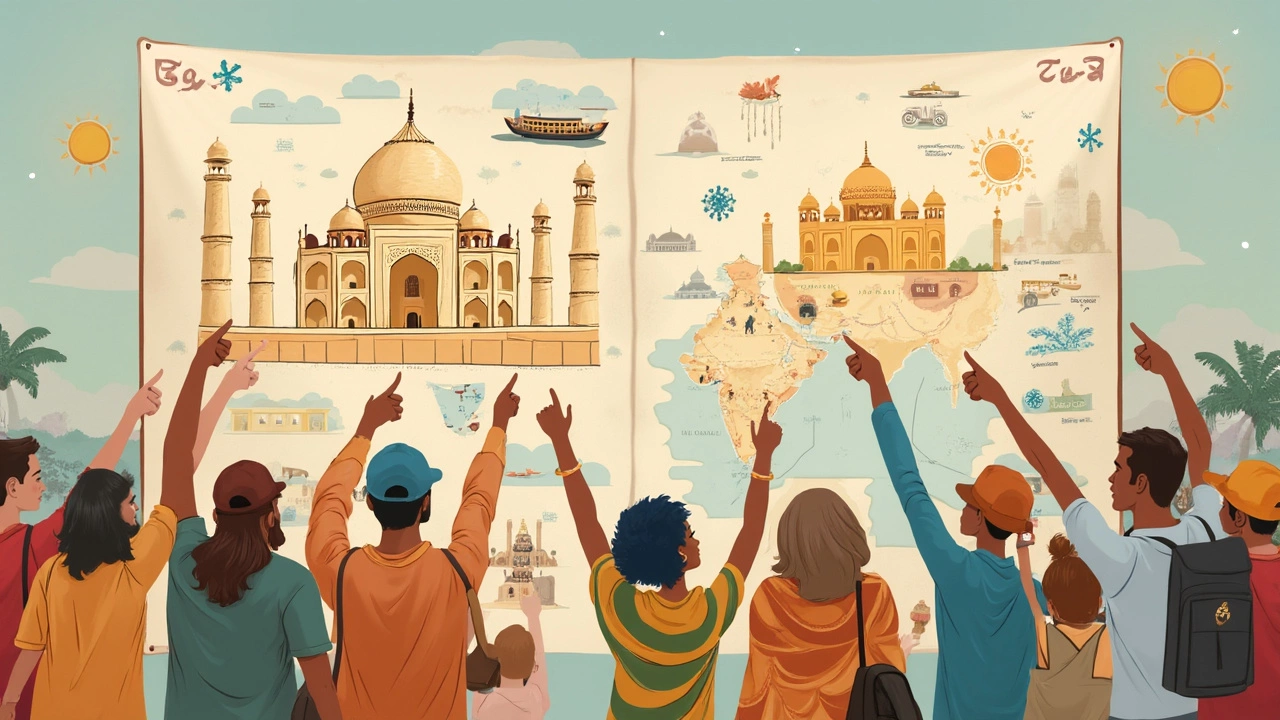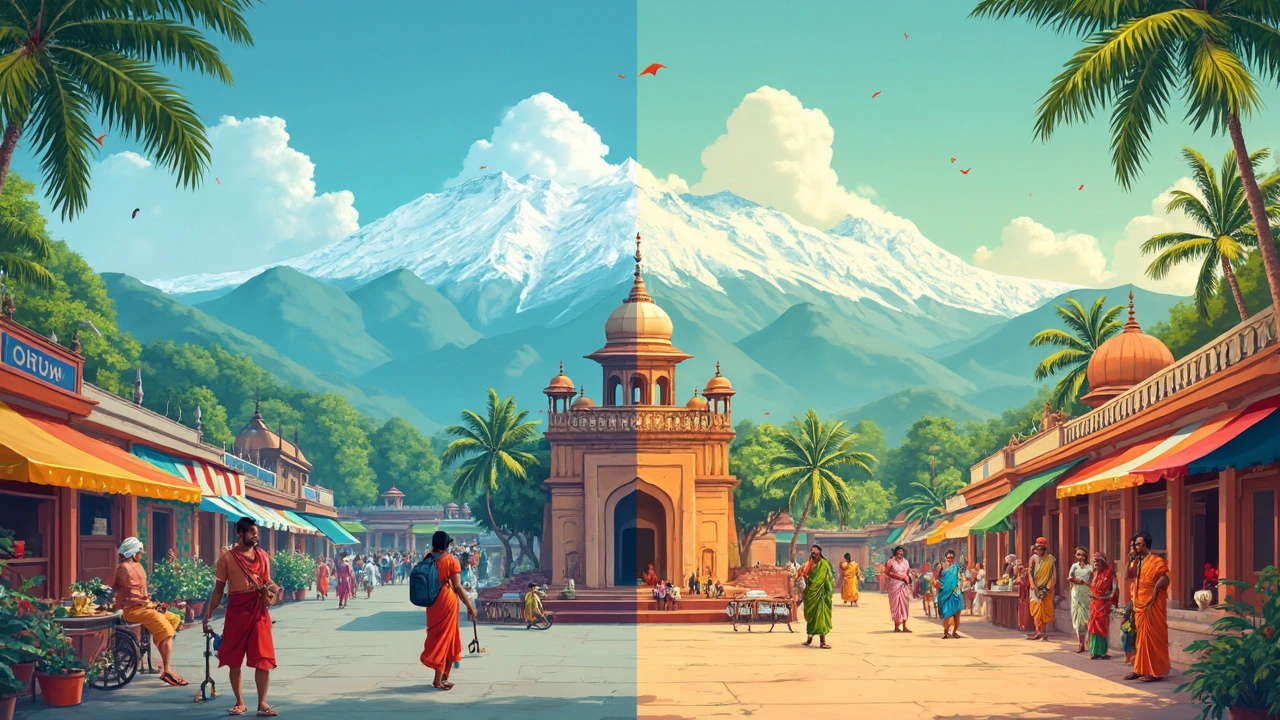The question of whether southern India is better than northern India is way more common than you might think. The truth? Both regions feel like two different worlds packed into one country. What really matters is what you’re looking for. If you want sun-drenched beaches, ancient temples covered in brightly colored sculptures, and food with bold, spicy flavors, the south is your playground. Prefer desert forts, busy bazaars, snowy mountains, and a deeper dive into Mughal history? Head north.
Here's a tip right off the bat: pack for the weather. Summers in the north can melt you if you’re not used to 40°C sunshine, while the south stays warm all year but gets drenched during monsoon season (June to September). If rain puts a damper on your plans, stick to October to February for the south.
- First Impressions: What Sets Them Apart
- Food, Festivals, and Culture Clash
- Best Destinations South vs North
- Travel Tips: Picking the Perfect Region for You
First Impressions: What Sets Them Apart
Touching down in South India or North India is like stepping into two completely different vibes. Down south, expect a laid-back pace with swaying coconut trees, quieter city chaos, and cleaner streets—especially in places like Kochi or Mysuru. Head north, and the energy jumps. Delhi, Jaipur, or Varanasi are all about nonstop movement, louder crowds, and the kind of hustle that hits you right as you leave the airport.
The architecture is a dead giveaway. South India serves up temple towns like Madurai and Thanjavur, where massive gopurams (temple towers) reach into the sky, packed with layers of colorful mythological figures. In contrast, the north is home to ornate Mughal forts, palaces, and the must-see Taj Mahal. You’d be hard-pressed to confuse a Rajasthani fort with a Dravidian temple—one looks straight out of a fairy tale, the other has mind-blowing sculpture work on every inch.
The landscape tells its own story. Northern India’s terrain is diverse—from the deserts of Rajasthan and bustling river ghats in Varanasi, to the towering Himalayas in Himachal. South India feels tropical almost everywhere, with lush hills in Kerala, palm-fringed beaches in Goa and Gokarna, and backwaters that feel like something out of a travel magazine.
Here's a handy breakdown:
| Region | Weather | Famous For |
|---|---|---|
| North India | Varied (hot summers, cold winters) | Deserts, Himalayas, Mughal monuments, street markets |
| South India | Mostly warm, wet monsoon (no snow) | Temples, beaches, backwaters, classical dance |
And if you want to mingle with locals, you’ll instantly notice the difference in language. The north leans on Hindi and a few regional dialects. South India is all about Dravidian languages—Tamil, Kannada, Telugu, Malayalam. English bridges the gap for tourists, but trying out even a few local words gets a lot of smiles.
Food, Festivals, and Culture Clash
If you’re into eating your way through a trip, North and South India travel will keep your taste buds on their toes. Northern India loves rich curries, creamy gravies, and eats a lot of wheat—think butter chicken, naan, and samosas. Street food is a whole scene, with Delhi’s chaat and Amritsar’s kulchas making it tough to pick a favorite snack. North Indian food isn’t shy about dairy or ghee either. Lassi, anyone?
Now, head south and you’ll find a totally different food story. Rice is life here. Breakfast might be crisp dosas with coconut chutney or idlis that are steamed so soft, they almost melt. If you like spicy food, the south has your back: Andhra food is legendary for its heat, and Chettinad cuisine in Tamil Nadu goes heavy on black pepper and aromatic spices. Filter coffee is a must—locals skip the instant stuff and swear by their traditional brews.
Festivals are a wild ride no matter where you land. In the north, Diwali (the festival of lights) lights up entire cities with lamps, fireworks, and mithai (sweets). Holi, the festival of colors, is a massive outdoor paint party. North Indian weddings? They’re extra in the best way—think days of dancing, bling, and food.
The south steps up with its own unique traditions. Onam in Kerala brings jaw-dropping flower carpets and feasts (called sadya) served on banana leaves. Pongal in Tamil Nadu marks the harvest with sweet rice pudding and colorful rangolis. Karnataka has Mysore Dasara, where the whole city transforms for ten days. India culture is woven into these festivals, but each region adds its own flavor—literally and figuratively.
The culture clash goes beyond food and parties. Clothing is an example. In the north, you’ll see salwar kameez, kurtas, and lots of bright embroidery. The south is all about the saree—usually cotton or silk, draped in styles unique to each state. Language is another biggie. Hindi helps in the north, but in the south, you’ll hear Tamil, Telugu, Kannada, and Malayalam. English works pretty much everywhere if you stick to touristy spots.
Here’s a quick comparison you might find handy:
| Aspect | North India | South India |
|---|---|---|
| Staple Food | Wheat (roti, naan) | Rice (dosa, idli) |
| Popular Festivals | Diwali, Holi, Dussehra | Onam, Pongal, Dasara |
| Top Languages | Hindi, Punjabi, Urdu | Tamil, Telugu, Kannada, Malayalam |
| Typical Attire | Salwar-kameez, kurta, saree | Saree, lungi, mundu |
| Spice Level | Medium, often creamy | Hot, tangy, coconut-based |
So, when you’re planning India destinations, don’t just flip a coin. Think about what makes you excited: the flavor of the food, the buzz of the festivals, or even the languages you want to try your hand at. Choosing the right region means you’ll come home with stories—and probably some new cravings.

Best Destinations South vs North
Trying to figure out whether to explore South India travel gems or go north? Both have spots that regularly end up on bucket lists for a reason. Let’s break it down, so you don’t miss what suits your vibe best.
Starting down south, places like Kerala are top picks for good reason. Hop on a houseboat in Alleppey—the backwaters here are calm, green, and way different from the rest of India. You’ll spot coconut trees everywhere. In Tamil Nadu, make time for the temples in Madurai and the colorful streets of Pondicherry. Karnataka’s Hampi feels like an open-air museum with giant boulders and old temples. If you’re after laid-back beaches, Goa (okay, it’s technically in the southwest but often grouped with the south for travelers) is unbeatable for both party spots and tucked-away sands.
Now, head up north and you’re in for a different kind of adventure. Hit up Delhi for its crazy mix of old forts and modern chaos. Jaipur gives you those classic pink palaces—and that’s not just a tourist slogan, the Old City really is painted pink. Agra’s Taj Mahal probably needs no intro, but go early in the morning to beat the crowds. Love mountains? Himachal Pradesh and Uttarakhand have hill stations like Manali and Nainital that actually get snow in winter. And Rajasthan’s Jaisalmer will wow you with its golden desert forts and camel rides.
Want to compare at a glance? Check this out:
| Region | Must-Visit Cities/Spots | What Makes It Special |
|---|---|---|
| South India | Kerala, Madurai, Hampi, Pondicherry, Goa | Backwaters, temples, beaches, unique food culture |
| North India | Delhi, Jaipur, Agra, Manali, Jaisalmer | Historic forts, palaces, Himalayan scenery, desert adventures |
Each list has its own flavor. If you thrive on heat and spice (in food and weather), the south will make you happy. If you want variety—think snow, sand, and big-city noise—the north won’t disappoint. I always tell friends to pick at least one spot that’s not a capital city to get a genuine feel for local life, whether it’s small-town Kerala or a Rajasthani village.
Travel Tips: Picking the Perfect Region for You
Ready to choose between South India travel and North India travel? Let’s talk facts you can actually use, not just opinions. First, think about your travel style. Do you like exploring stuff at a laid-back pace, chilling by the beach, and less crowded tourist spots? South India (Kerala, Tamil Nadu, Karnataka, Andhra Pradesh) checks those boxes. Into chaos, color, and never-ending street food—plus iconic spots like the Taj Mahal and Rajasthan’s palaces? The north is for you.
- If you’re traveling in winter (November–February), both regions are pleasant, but South India travel promises lighter crowds and smaller cities if you hate big crowds.
- Veggie foodies—south is a paradise. Think dosai, idli, filter coffee, and thousands of little local dishes. The north shines for street snacks like samosas and chaat but also lots of hearty meat curries.
- Hate long travel days? South India has good train connections between major cities, many less than 7 hours apart. North travels can mean 12–20 hour journeys, especially if you want to hit up places like Varanasi, Delhi, and Jaipur.
- Love beaches? South is packed with options like Varkala, Gokarna, and Pondicherry. The north’s coastlines don’t offer much for swimmers or sunbathers.
If you care about festivals, timing matters. North India goes wild for Diwali and Holi, but in the south, check out Onam (Kerala) and Pongal (Tamil Nadu)—they’re more about local tradition than big parties but super welcoming to outsiders.
Worried about language? English works everywhere, but in the south, people often switch to English much faster if you get stuck, partly because each state has its own language (Tamil, Kannada, Malayalam, Telugu). Up north, Hindi is everywhere, so pick up a few words if you want smoother bus and train trips.
| Feature | South India | North India |
|---|---|---|
| Main Destinations | Kerala, Mysore, Hampi, Chennai | Delhi, Jaipur, Agra, Varanasi |
| Best Time to Visit | October–February | October–March |
| Popular Foods | Dosa, idli, sambar | Chaat, paneer, butter chicken |
| Transport | Easy, short train rides | Longer train journeys |
| Beaches | Yes | Not really |
So, for chill vibes, palm trees, and steady weather, book a trip to the south. After Insta-famous sights, desert forts, and festivals where the crowds go wild? Head north. Or do both—India’s train journeys (even the crowded ones) can be part of the adventure.
